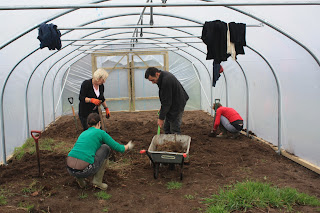I spent two weeks working and living at Bosavern Farm as part of the Worldwide Opportunities on Organic Farms (WWOOF) scheme. While it would be impossible to convey every positive I took from the experience and still keep this account a reasonable length, I’ll try to relay exactly what I learnt from my time on the farm as well as try to get across why community farming projects like Bosavern are so important.
Perhaps the most widely known positive of community farming is its environmental impact, or rather lack of. When it comes to small community farms like Bosavern the distances involved in transporting food – from the ground, to the point of sale, to the consumer’s kitchen table - could in some cases be measured in mere metres. Supermarkets on the other hand are the antithesis of this low impact model. They often import vast quantities of food from abroad, a process heavily dependent on fossil fuels for transportation. They also operate a production network of increasingly centralised intensive farms, meaning even the produce grown in the UK has to travel cross country, by lorry, to get to supermarket stores, probably via large sorting warehouses. In a world of increasingly scarce natural resources and awareness of the importance of reducing the first world’s carbon footprint it’s a model that is no longer sustainable. Community farms cut food miles down to, potentially, zero. When working at Bosavern the potatoes I harvested travelled - from soil to the farm gate where they are sold – I think about 50 metres, by wheelbarrow, powered by me. If the customer then travels by foot to buy them from the gate those potatoes are effectively carbon neutral.
This reduced distance between a community farm and the customer is not just literal. The centralisation of our food system has created a disconnect between our food and where it comes from, meaning as a society we have no relationship with the people and land that produce our food. For many members of the public food simply appears on super market shelves as if by magic, they can’t put a human face to the people who sow, grow and harvest the crops they eat. This is convenient for the handful of companies that control our food system: when a customer buys a cheap tomato they think only about the price, the farmer who’s receiving an increasingly diminishing return for his crop is out of sight, and therefore out of mind. At Bosavern the majority of conversations members of the community had with Hugh were predictably about food; what was good that week, what crops would soon be harvested, which ones were coming along well, which were struggling a bit, how the weather was affecting production. Imagine asking the shelf stacker in Tesco’s how that season’s broad beans were maturing. Living in close proximity, and having access to where our food is produced reconnects us to its origin and produces a more empathetic relationship between the producer and consumer. Bosavern, through the volunteer and community aspects of the farm, has bridged this gap altogether, making consumer and producer almost one and the same.
Being a community farm creates a link of mutual interest between Bosavern and local residents. It also earns them the right to voice their opinion on how it’s run and encourages involvement in the day to day goings on at the farm, through volunteering and getting involved with fundraising or the educational activity days. This enfranchisement, the feeling of having an influence on something that matters (and what matters more than food!), encourages inclusion, provides a feeling of personal fulfilment and both creates and strengthens community ties. Volunteers at Bosavern and farms and institutions like it have the unique satisfaction of involvement at potentially all levels of production; they have a say on what’s grown, they can sow the seeds, harvest the crop, then have a say on where the money made through selling the produce goes.
Despite taking a keen interest in where my food came from before I arrived at the farm, I realised within hours of arriving how narrow my knowledge of vegetables actually was. Just by taking one quick circuit of the Poly-tunnel I was exposed to several varieties of salad that I’d never heard of, let along eaten. Mizuna and mibuna, both viable alternatives to the more common rocket for adding a peppery taste to salads, were two that spring to mind. On my first night there Hugh made a tasty spaghetti ‘chard-ongese’, I’d heard of chard but again I had no recollection of having eaten it before. This seems absurd when you consider how worthy a substitute it can be for spinach (tougher, less likely to wilt to nothing in your fridge within a couple of hours of purchasing). This of course reflects a truth that is well known in certain circles in the UK but not in the country as a whole; while supermarkets may give the illusion of choice the range of vegetables and foodstuffs on offer is actually very limited. Apples are a good example of this. Roughly 3000 different varieties of apples exist in the UK, however only a few are widely available in UK supermarkets. If we as a country embraced a wider variety of home-grown apples (and this goes for many other fruit and vegetables) we could vastly lessen our dependence on foreign imports. By aiming towards at least an ideal of community self-sufficiency farms like Bosavern encourage exploration; if you’re going to pursue a diet whereby locally grown produce makes up the majority of your ingredients, you’re going to have to widen your palette beyond what’s available in supermarkets. This opens up the opportunity to embark on a gastronomic journey of discovery, an exploration into new varieties of fruit and veg and culinary combinations, like Hugh’s ‘chard-ongese’, for instance!
JohnX














